| Srl | Item |
| 1 |
ID:
105121
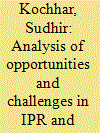

|
|
|
|
|
| Publication |
2011.
|
| Summary/Abstract |
This paper assimilates and contributes to the current state of IPR knowledge and proprietary products in the Indian jurisdiction. The influence of international IPR domain and influx of proprietary foreign technology products on Indian agricultural technology profile vis-à-vis the plight of the national players is discussed, particularly, with respect to patenting in plant biotechnology/transgenics. The factual scenario under the national PPV&FR regime is narrated. This paper also analyses the recent foreign interests in respect of patenting in the areas of animal vaccines and diagnostics vis-à-vis the existing strength of the national system, which needs to be maintained.
|
|
|
|
|
|
|
|
|
|
|
|
|
|
|
|
| 2 |
ID:
092832


|
|
|
|
|
| Publication |
2009.
|
| Summary/Abstract |
The clean development mechanism (CDM) contributes to technology transfer by financing emission reduction projects using technologies not available in the host countries. This paper provides the most comprehensive analysis of technology transfer in the CDM to-date, covering 3296 registered and proposed projects. Roughly 36% of the projects accounting for 59% of the annual emission reductions claim to involve technology transfer. Technology transfer is more common for larger projects and projects with foreign participants. Technology transfer is very heterogeneous across project types and usually involves both knowledge and equipment. As the number of projects increases, technology transfer occurs beyond the individual projects. This is observed for several of the most common project types in China and Brazil with the result that the rate of technology transfer for new projects in those countries has fallen significantly.
|
|
|
|
|
|
|
|
|
|
|
|
|
|
|
|
| 3 |
ID:
185275
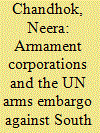

|
|
|
| 4 |
ID:
014717
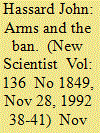

|
|
|
|
|
| Publication |
Nov 28, 1992.
|
| Description |
38-41
|
|
|
|
|
|
|
|
|
|
|
|
|
|
|
|
| 5 |
ID:
062197
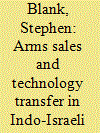

|
|
|
|
|
| Publication |
Spring/Summer 2005.
|
|
|
|
|
|
|
|
|
|
|
|
|
|
|
|
| 6 |
ID:
001502
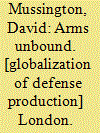

|
|
|
|
|
| Publication |
London, Brassey's (US), 1994.
|
| Description |
xx, 88p.
|
| Standard Number |
002810899
|
|
|
|
|
|
|
|
|
|
|
|
Copies: C:1/I:0,R:0,Q:0
Circulation
| Accession# | Call# | Current Location | Status | Policy | Location |
| 041020 | 338.476233/MUS 041020 | Main | On Shelf | General | |
|
|
|
|
| 7 |
ID:
124772


|
|
|
|
|
| Publication |
2013.
|
| Summary/Abstract |
Technological ties between Israel and China have always been a central and constant element of their relationship. Defense contracts played a leading role here but were also responsible for the severe crisis that erupted between the countries in the early 2000s after Israel, capitulating to US pressure, backed off from its commitment to provide China with military technologies. This not only forced Israel to sever its defense relations with China but also made US-Israel relations a principal factor in the Sino-Israeli connection and imposed tight constraints on Israel's technology transfers to China generally. For Israel, this placed the dilemma of commercial versus political and national security interests at the forefront, since technology connections allowed it to promote its economic, political, and strategic causes through China. Indeed, while technology ties between the states have not stopped entirely-they have shifted to the civilian sphere-technology transfers to China are subject to heavy limitations, and Israel's export control mechanism faces greater challenges to screen them. As China's economic and political influence is ever increasing, Israel's cautious approach to technology transfers to China may be expected to come under mounting pressure.
|
|
|
|
|
|
|
|
|
|
|
|
|
|
|
|
| 8 |
ID:
008591
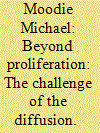

|
|
|
|
|
| Publication |
Spring 1995.
|
| Description |
183-202
|
|
|
|
|
|
|
|
|
|
|
|
|
|
|
|
| 9 |
ID:
094962
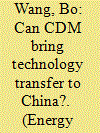

|
|
|
|
|
| Publication |
2010.
|
| Summary/Abstract |
China has undertaken the greatest number of projects and reported the largest emission reductions on the global clean development mechanism (CDM) market. As technology transfer (TT) was designed to play a key role for Annex II countries in achieving greenhouse gas emission reductions, this study examines various factors that have affected CDM and TT in China. The proportion of total income derived from the certified emissions reductions (CER) plays a key role in the project owners' decision to adopt foreign technology. Incompatibility of CDM procedures with Chinese domestic procedures, technology diffusion (TD) effects, Chinese government policy and the role of carbon traders and CDM project consultants all contribute to the different degrees and forms of TT. International carbon traders and CDM consultants could play a larger role in TT in China's CDM projects as investors and brokers in the future.
|
|
|
|
|
|
|
|
|
|
|
|
|
|
|
|
| 10 |
ID:
187348
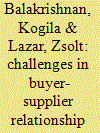

|
|
|
|
|
| Summary/Abstract |
Transfer of technology (TOT) is a contentious issue in the international defence trade. In 2019 it was estimated to form at least 40%, or $123 billion USD, of total international defence trade. Whilst purchasing nations set requirements for TOT within their industrial participation (IP) policies, there is often a mismatch between the scale and type of technology suppliers can offer and the buyer’s technological absorption capability (TAC). This persistent tension between ambition and reality frequently strains the buyer-supplier relationship. Thus, understanding how TAC can be enhanced is of vital importance. This paper defines TAC in the international defence acquisition and offsets context and determines the factors for successful TAC. The paper focusses on the potential challenges for successful TAC and offers recommendations on how to enhance TAC. This research is limited to the context of Southeast Asia. The respondents consist of industry, government and academics who operate in the Southeast Asian defence and security sector.
|
|
|
|
|
|
|
|
|
|
|
|
|
|
|
|
| 11 |
ID:
126781
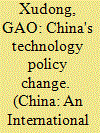

|
|
|
|
|
| Publication |
2013.
|
| Summary/Abstract |
The Chinese central govemment held the 4th National Conference on Science and Technology on 9 January 2006. At this important meeting. President Hu jintao and Premier Wen Jiabao made their speeches and announced the decision to develop China into an innovative country. On the same day. the State Council announced and issued the "National Guideline on Medium and Long-term Program for Science and Tech-
nology Development (2006-2020)'. According to the Guideline. by 2020. China': entire investment in resarch and development (R&D) is expected to ruch 2.5 per cent of the country's gross domestic product. while science and technology will contribute to about 60 per cent of the country's economic development.'
|
|
|
|
|
|
|
|
|
|
|
|
|
|
|
|
| 12 |
ID:
105137
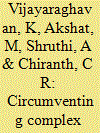

|
|
|
|
|
| Publication |
2011.
|
| Summary/Abstract |
Licensing of technologies by companies and research institutes is a recent phenomenon that has gained immense popularity in the agricultural sector, it being imperative for the research fraternity to gain access to validated technologies, enhance their product portfolio, and accelerate access to commercialization ensuring outreach of good science to farmers. Two case studies pertaining to rice and chickpea are discussed in the paper to elucidate this process.
|
|
|
|
|
|
|
|
|
|
|
|
|
|
|
|
| 13 |
ID:
016705
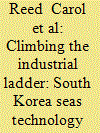

|
|
|
|
|
| Publication |
July 31, 1993.
|
| Description |
20-25
|
|
|
|
|
|
|
|
|
|
|
|
|
|
|
|
| 14 |
ID:
004727
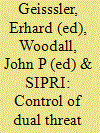

|
|
|
|
|
| Publication |
Oxford, University Press, 1994.
|
| Description |
xviii, 265p.; tables
|
| Series |
SIPRI Chemical and Biological Warfare Studies; no.15
|
| Standard Number |
0198291728
|
|
|
|
|
|
|
|
|
|
|
|
Copies: C:1/I:0,R:0,Q:0
Circulation
| Accession# | Call# | Current Location | Status | Policy | Location |
| 035654 | R 355.82516/GEI 035654 | Main | On Shelf | General | |
|
|
|
|
| 15 |
ID:
031115


|
|
|
|
|
| Publication |
New York, Pergamon Press, 1981.
|
| Description |
xx, 544p
|
| Series |
Pergamon policy studies on international development.
|
| Standard Number |
0080271084
|
|
|
|
|
|
|
|
|
|
|
|
Copies: C:1/I:0,R:0,Q:0
Circulation
| Accession# | Call# | Current Location | Status | Policy | Location |
| 020878 | 338.926/SAG 020878 | Main | On Shelf | General | |
|
|
|
|
| 16 |
ID:
001504
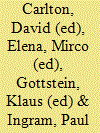

|
|
|
|
|
| Publication |
Aldershot, Dartmouth, 1995.
|
| Description |
xx,231p.
|
| Standard Number |
1855215357
|
|
|
|
|
|
|
|
|
|
|
|
Copies: C:1/I:0,R:0,Q:0
Circulation
| Accession# | Call# | Current Location | Status | Policy | Location |
| 036446 | 338.926/CAR 036446 | Main | On Shelf | General | |
|
|
|
|
| 17 |
ID:
016291
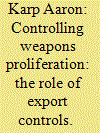

|
|
|
|
|
| Publication |
March 1993.
|
| Description |
18-45
|
|
|
|
|
|
|
|
|
|
|
|
|
|
|
|
| 18 |
ID:
157561
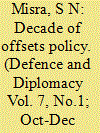

|
|
|
| 19 |
ID:
144824
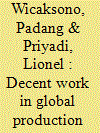

|
|
|
|
|
| Summary/Abstract |
Despite growing investment from leading automotive makers, particularly Japanese companies, the Indonesian automotive sector is still struggling to ensure decent work. This article makes a particular attempt to analyse the close links between Decent Work (DW) and Global Production Networks (GPNs) in the Indonesian automotive sector, whilst scrutinizing the existing literature that has covered the two concepts in separate frameworks. More specifically, this article examines the employment opportunities and adequate earnings of local employees within the DW framework in the country’s automotive sector with the expansion of GPNs. It finds that although there were greater opportunities for skilled workers to upgrade capabilities and enjoy improved welfare outcomes, there are still many more less-skilled workers remaining in precarious conditions.
|
|
|
|
|
|
|
|
|
|
|
|
|
|
|
|
| 20 |
ID:
105498
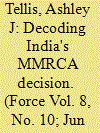

|
|
|